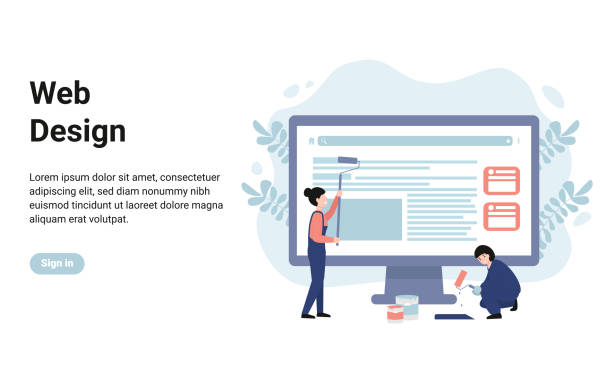An Introduction to SEO-Optimized Website Design and its Importance
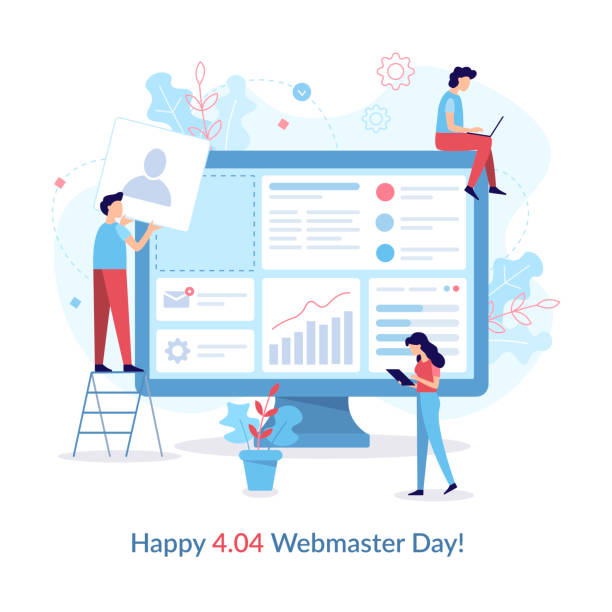
In today’s highly competitive digital world, simply having a website is not enough; your website needs to be seen! This is where the concept of #SEO_Optimized_Website_Design becomes important.
SEO, or Search Engine Optimization, is the process of preparing your website for better ranking in search engine results like Google.
But where does this process begin? Exactly from the design phase! A website design that considers SEO principles from the very beginning can make a huge difference in your incoming traffic and, ultimately, the success of your online business.
The main goal of an SEO-optimized website design is to build a platform that is not only attractive and functional for users but also understandable and trustworthy for complex search engine algorithms.
This means adhering to technical details, information architecture, URL structure, and even selecting the right platform.
Why should we think about SEO-optimized website design from the very beginning of a project? The answer is simple: fundamental changes to a website that was not designed to be SEO-friendly from the start can be costly and time-consuming.
Like building a house on a strong foundation, a website also needs a strong SEO foundation to withstand market competition and achieve sustainable growth.
This approach not only reduces long-term costs but also ensures a higher return on investment (ROI).
Furthermore, search engines are increasingly valuing user experience (UX), and a good SEO-optimized website design simultaneously provides an excellent user experience.
This synergy is key to achieving high rankings and attracting target audiences.
So, let’s delve deeper into the various aspects of this process and understand how we can build a website that is ideal for both users and search engines.
Does your company’s website perform as it should for your brand? In today’s competitive world, your website is your most important online tool. Rasaweb, a specialist in professional corporate website design, helps you to:
✅ Attract customer credibility and trust
✅ Convert website visitors into customers
⚡ Get a free consultation now!
Core SEO Principles in Web Design
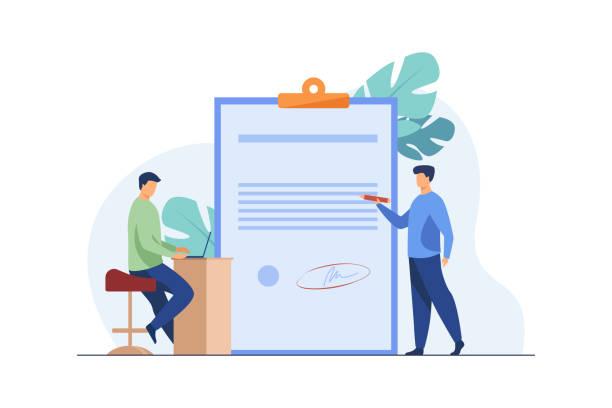
When it comes to SEO-optimized website design, there are fundamental principles that must be considered from the very first moment.
These principles are the cornerstone of a strong and competitive website in search results.
One of the most important is website structure.
A logical hierarchical structure that users and search engine crawlers can easily navigate is crucial.
This includes clear categories, intuitive navigation menus, and effective internal linking.
Optimized URLs also play an important role.
URLs should be short, descriptive, and contain keywords to be understandable for users and to help search engines understand the page content.
Website loading speed is another factor that search engines and users greatly value.
A slow site will have a high bounce rate and negatively impact SEO rankings.
Image optimization, file compression, and caching are among the solutions for improving speed.
Also, in the mobile-first era, responsiveness and mobile compatibility are an undeniable requirement.
Website design should be such that it provides a consistent user experience across all devices, from desktops to tablets and mobile phones.
This is not only vital for SEO but also increases user satisfaction.
Proper use of heading tags (H1-H6) for content structuring and meta tags (title and description) for attractive display in search results are among other fundamental principles in this area.
An SEO-optimized website design, by adhering to these principles, paves the way for visibility.
Keyword Research and its Role in Site Architecture
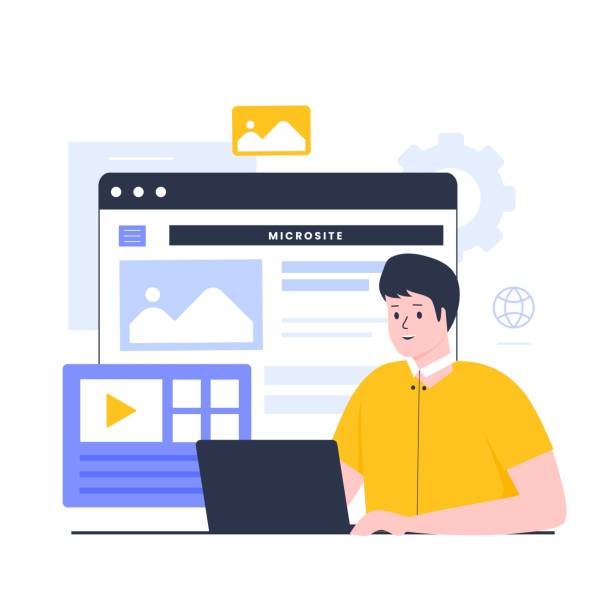
Keyword research is the backbone of any SEO strategy and, consequently, of any successful SEO-optimized website design.
Before even a line of code is written or a visual element is designed, we need to know exactly what our target audience is looking for and what words they use to search for it.
This stage goes beyond finding high-volume keywords; it involves understanding user search intent and aligning the site’s content with those needs.
Keywords should be intelligently incorporated not only into the content but also into the website’s information architecture, URL structure, and page titles.
This means each page should be designed around one or more main keywords, and internal navigation should connect related pages to increase their SEO power.
After identifying suitable keywords, it’s time to organize them.
This is where the role of keywords in site architecture becomes apparent.
A website with strong architecture is like an organized library where every section, shelf, and book is easily found.
Main keywords are typically used for homepages and categories, while long-tail keywords are used for sub-pages and blog articles.
This organization helps search engines understand your site’s thematic structure and match relevant pages with corresponding searches.
Below is an example of how keywords are allocated to the site structure:
| Page Type | Target Keywords | Example |
|---|---|---|
| Homepage | Broad keywords and branding | Web design services, SEO company |
| Category Pages | More general keywords related to the field | E-commerce website design, local SEO |
| Product/Service Pages | Precise and specific product keywords | Mobile app design for Android |
| Blog Articles | Long-tail keywords, user questions | How to improve website speed? |
This approach ensures that every part of the site is optimized as best as possible for search and achieves the goals of a comprehensive SEO-optimized website design.
Technical Site Optimization from an SEO Perspective

Technical optimization is one of the most complex yet critical aspects of SEO-optimized website design.
This section includes all settings and codes that help search engines better understand, crawl, and index your website.
Without proper technical optimization, even the best content and most beautiful design may never reach top rankings.
One of the first steps is managing the Robots.txt file, which tells search engine crawlers which parts of the site they can or cannot visit.
This is crucial for preventing low-value or duplicate pages from being indexed.
The Sitemap.xml is also an essential tool that introduces all important pages and content of your website to search engines.
This file helps them understand your site structure more quickly and efficiently.
Canonical Tags are used to prevent duplicate content issues, which can severely impact your SEO ranking.
These tags tell search engines which version of a page is the original and authoritative one.
Additionally, implementing Structured Data (Schema Markup), also known as Schema.org, provides search engines with more information about your content and can lead to the display of Rich Snippets in search results, which increases visual appeal and click-through rate (CTR).
Managing 404 errors and 301 redirects are also important technical aspects.
Pages that no longer exist or whose addresses have changed should be properly redirected to new relevant pages to prevent loss of link equity and negative user experience.
Finally, website security through HTTPS protocol is an important ranking factor and also builds user trust.
The sum of these technical factors provides a robust infrastructure for SEO and ensures that your efforts in other SEO areas come to fruition.
Does your current website convert visitors into customers, or does it scare them away? Solve this problem forever with professional corporate website design by Rasaweb!
✅ Build credibility and powerful branding
✅ Attract target customers and increase sales
⚡ Get a free consultation now!
Producing SEO-Optimized Content in the Design Process
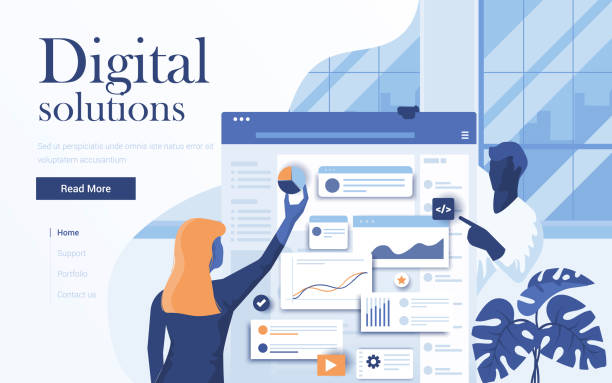
Content is king, but SEO-optimized content is emperor! In the process of SEO-optimized website design, content production should not be considered a post-design phase, but rather planned and executed from the beginning and in parallel with design.
The close relationship between design and content is because the site’s template and structure design must be able to display and highlight optimized content.
This part of the work is not limited to writing text; it also includes selecting images, videos, and even podcasts, considering keywords and optimization principles.
Your content should be useful, engaging, and responsive to your target users’ questions, not just for search engines.
Question-provoking content encourages users to interact more with the site and spend more time on pages, which is a positive signal for search engines.
Use engaging titles, captivating introductions, and short, scannable paragraphs.
Strategic use of keywords throughout the text, without overdoing it and keyword stuffing, is very important.
In addition to text, optimizing visual content is also crucial.
Images should be uploaded with low volume and high quality, and have descriptive alt tags containing keywords to be understandable for both visually impaired users and search engines.
Videos should also be optimized with appropriate titles, descriptions, and tags.
Creating regular and new content through a blog is one of the most effective ways to attract organic traffic and establish site authority in a specific area.
This continuous approach to producing valuable content is an integral part of a website optimization strategy.
By combining high-quality content and user-friendly design, we can ensure that the site not only ranks well but also attracts and retains its audience.
User Experience (UX) and its Impact on SEO

The relationship between user experience (UX) and SEO is a symbiotic one that has become increasingly important in recent years.
Search engines, especially Google, are constantly evolving their algorithms to provide the best possible experience for users.
Therefore, a truly SEO-optimized website design would not be complete without considering UX principles.
When a user enjoys visiting your website, they spend more time on the site, visit more pages, and are likely to return to your site.
These behaviors send positive signals to search engines, indicating the quality and value of your website.
Key UX elements that help SEO include clear and simple navigation, attractive visual design, text readability, and optimal loading speed.
Complex navigation or a cluttered design can confuse users and cause them to quickly leave the site (increasing the bounce rate).
A high bounce rate is a negative signal for search engines and can harm your ranking.
On the other hand, a logical navigation structure and easy access to information encourage users to explore the site further.
Text readability, achieved through appropriate font choice, font size, color contrast, and sufficient white space, improves user experience and also helps search engines understand the content.
Additionally, accessibility for all users, including those with disabilities, is not only an ethical principle but also helps SEO because search engines prefer websites that are accessible to everyone.
Ultimately, a website design that carefully focuses on user experience not only leads to better search rankings but also converts users into loyal customers.
In fact, UX and SEO are two sides of the same coin, both contributing to the ultimate goal of SEO: online success.
Ignoring one means harming the other.
Website Loading Speed and its Importance
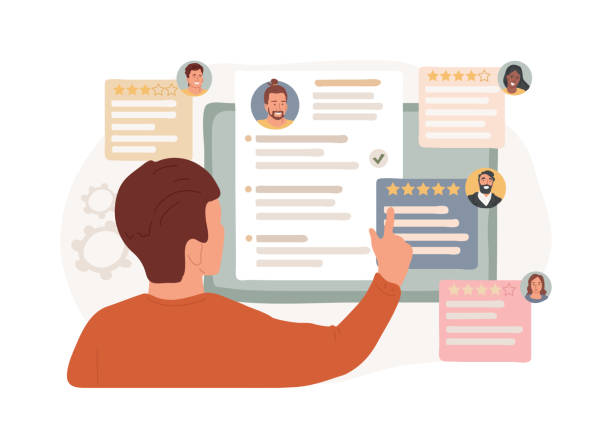
Website loading speed is one of the most critical factors in SEO-optimized website design and user experience, considered a significant ranking factor by search engines, especially Google.
In today’s fast-paced world, users expect websites to load instantly.
Studies have shown that even a one-second delay in page loading can reduce conversion rates and significantly increase the bounce rate.
For SEO, faster loading speed means more efficient indexing by search engine crawlers, as they can visit more pages in less time.
This not only helps new content to be seen faster but also signals to search engines that your website is efficient and user-friendly.
There are several key methods to improve website loading speed.
The first and perhaps most important step is image optimization.
High-volume images can severely slow down a website.
Using modern image formats like WebP, compressing images without significant quality loss, and specifying exact image dimensions in HTML code are among the solutions.
Tools like Google PageSpeed Insights can help you identify speed issues and provide solutions.
Using browser and server caching is also highly important, as it allows users to load site content faster for subsequent visits.
Compressing CSS and JavaScript files, reducing HTTP requests, and using a CDN (Content Delivery Network) to deliver content from the closest server to the user are other effective techniques.
Choosing a quality hosting provider and optimizing the database can also have a significant impact on overall site performance.
Ultimately, paying attention to these technical details not only benefits the site’s SEO but also directly affects your user experience and, consequently, your business success.
A website with optimal loading speed has greater efficiency and user engagement.
Below is a table illustrating the impact of site speed on performance:
| Loading Time (seconds) | Likelihood of Increased Bounce Rate | Impact on Conversion Rate |
|---|---|---|
| 1-3 | 32% increase | Usually good |
| 3-5 | 90% increase | Medium to poor |
| 5+ | 123% increase | Very poor |
Responsiveness and Mobile Compatibility

In the current era, where smartphone usage for internet access is increasing, responsiveness and mobile compatibility are no longer an option, but a necessity in SEO-optimized website design.
Google, by introducing the Mobile-First Indexing algorithm, has explicitly stated that the mobile version of your website will be the primary basis for ranking and indexing.
This means that if your site does not perform well on mobile devices, regardless of the quality of the desktop version, your SEO ranking will be severely affected.
A responsive design ensures that your website automatically adjusts to the screen size of the user’s device, without the need for zooming, horizontal scrolling, or loss of content.
A responsive website is not only preferred by search engines but also significantly improves user experience.
Mobile users expect to be able to easily navigate your site and find the information they need.
A poor mobile user experience can lead to high bounce rates and reduced engagement.
When designing for mobile, special attention should be paid to factors such as appropriate font size for readability, sufficient space between elements for easy touch, and simplified navigation.
Images and videos should also be optimized for mobile devices to prevent slow loading speeds.
Additionally, input forms should be designed to be easy to fill out with a mobile keyboard, and buttons should be large enough.
To check your website’s mobile compatibility, you can use tools like Google’s Mobile-Friendly Test.
This tool shows you how mobile-friendly your site is from Google’s perspective and what improvements are needed.
Ultimately, investing in mobile-optimized website design ensures that you not only achieve a better SEO position but also attract and satisfy a huge segment of internet users who use mobile phones.
Tired of losing customers due to poor e-commerce website design? With Rasaweb, solve this problem forever!
✅ Increase sales and conversion rate of visitors to customers
✅ Smooth and engaging user experience for your customers⚡ Get a free consultation now!
Internal and External Linking for Better SEO

Links are the lifeblood of the internet and a key element in any SEO-optimized website design.
They help search engines discover different pages of your website, understand the relationships between content, and transfer page authority through internal and external links.
Internal linking means creating links between different pages of your own website.
This helps search engines better understand your website’s structure and find and index deeper pages.
Additionally, internal links help distribute link juice throughout your site and strengthen more important pages.
Using descriptive and relevant anchor text in internal links is highly important; instead of “click here,” use phrases like “specialized SEO consultation.”
On the other hand, external linking or backlinking refers to links provided from other websites to your site.
These backlinks are considered “votes of confidence” from other websites to your content and are one of the strongest ranking signals for search engines.
The quality of backlinks is much more important than their quantity.
A backlink from a reputable and relevant website in your industry can have a much greater impact than dozens of backlinks from low-authority and irrelevant sites.
External linking strategies include creating high-quality content that naturally attracts links, guest posting, and participating in specialized forums.
When implementing links on an optimized website, ensure that links function correctly and there are no broken links.
Broken links not only disrupt user experience but are also harmful to SEO.
Also, using nofollow tags for links you don’t want to pass SEO authority to (such as advertising links) is important.
A comprehensive linking strategy, both internal and external, can significantly improve your website’s SEO ranking and make it more visible in search engines.
Continuous Maintenance and Updates to Maintain Ranking

Optimizing a website for search engines is not a one-time process, but an ongoing journey.
After design and launch, continuous maintenance and updates are crucial for preserving and improving acquired rankings in search engines.
Google’s and other search engines’ algorithms are constantly changing, competitors are striving to surpass you, and user expectations are constantly evolving.
Therefore, a static website that is left untouched after design will quickly lose its value and ranking.
Monitoring SEO performance through tools like Google Search Console and Google Analytics is the first step in this process.
These tools provide you with valuable information about the keywords through which you receive traffic, popular pages, indexing issues, and broken links.
Based on this data, you should regularly update your content; rewrite old articles, add new information, and ensure their relevance to users’ current needs.
Also, technical site optimization should be continuously reviewed.
Speed issues, 404 errors, and mobile responsiveness problems should be resolved as soon as they are identified.
Monitoring competitors and analyzing their SEO strategies can also inspire new ideas for updating and improving your site.
Furthermore, with changing web trends and technologies, there may be a need to implement new features or improve the site’s technical infrastructure.
This could include migrating to HTTPS (if not already done), implementing PWA (Progressive Web App), or optimizing for voice search.
The long-term success of a site optimization project depends not only on the initial design but also on a continuous commitment to improvement and adaptation to the changing web landscape.
This is an endless journey to attract and retain audiences and convert them into loyal customers.
Frequently Asked Questions
| Question | Answer |
|---|---|
| What does SEO-optimized website design mean? | Designing a website that, in addition to an attractive appearance, is technically and content-wise optimized to achieve a higher ranking in search engine results. |
| Why is SEO-optimized website design important? | It leads to increased organic traffic through search engines, improved business visibility, attracting more customers, and ultimately increased sales. |
| What are the key elements in SEO-optimized website design? | Mobile optimization, fast loading speed, high-quality and relevant content, proper use of keywords, appropriate URL structure, and use of title and meta tags. |
| What role does content play in website SEO? | Unique, valuable, informative, and keyword-targeted content plays a vital role in attracting users and achieving better rankings in search results. |
| What is Mobile-First Indexing? | A Google approach where the mobile version of a website is prioritized for indexing and ranking. Therefore, site responsiveness for mobile is essential. |
| How can website loading speed be improved? | Compressing images, using caching, optimizing CSS and JavaScript codes, using a strong hosting provider, and enabling Gzip compression. |
| What is the importance of keywords in SEO? | Keywords help search engines understand the topic of your page and link it to relevant user searches. |
| What role do Title Tags and Meta Descriptions play? | The title tag is the most important element in on-page SEO, and the meta description is a summary of the page content that encourages users to click. Both are displayed in search results. |
| How does Internal Linking help SEO? | It helps search engines discover and index different pages of the site and distributes page value across different parts of the site. It also improves user experience. |
| What is the use of a Sitemap in SEO? | An XML file that provides a list of all important pages of the site to search engines to facilitate site crawling and indexing. |
And other advertising services from Rasa Web Advertising Agency:
Smart Advertising Campaign: An effective tool for online growth using intelligent data analysis.
Smart Marketing Automation: A fast and efficient solution for increasing sales with a focus on attractive UI design.
Intelligent Data Analysis: An effective tool for digital branding with marketing automation.
Smart Website Development: A novel service to improve SEO ranking through attractive UI design.
Smart Reportage: A creative platform to improve website traffic with marketing automation.
And over a hundred other services in the field of internet advertising, advertising consulting, and organizational solutions.
Internet Advertising | Advertising Strategy | Advertorials
Resources
Comprehensive Guide to SEO-Optimized Website DesignSEO-Optimized Website Design PrinciplesPractical Tips for SEO Website DesignOnline Success with an SEO-Optimized Site
? For your business to soar in the digital world and achieve unprecedented success, Rasaweb Digital Marketing Agency is by your side with its expertise and experience. From user-friendly website design and SEO optimization to executing targeted advertising campaigns, we are ready to transform your brand in the online space and pave the way for sustainable growth for you.
For consultation and services, contact us.
📍 Tehran, Mirdamad Street, next to Central Bank, Southern Kazeroun Alley, Ramin Alley, No. 6

